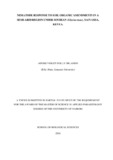Nematode response to soil organic amendments in a semi-arid region under soybean (Glycine max), Naivasha, Kenya.

View/
Date
2016Author
Orlando, Aduke V D
Type
ThesisLanguage
enMetadata
Show full item recordAbstract
Agricultural production within the smallholder farming sector of East Africa is constrained by
numerous factors including parasitic nematodes. Existing control measures involving applications of
chemical nematicides are not viable in the medium to long term due to environmental concerns
relating to toxic residues. There is therefore a need to develop alternative control options for
integrated parasitic nematode management that will promote soil eco health and reduce parasitc
nematode densities. This study evaluated population changes of soil nematodes, root galling and
changes in soil properties following addition of soil organic amendments in a semi-arid region under
soybean cultivation. Biochar, Vermicompost and Mycorrhizae were incorporated as organic
amendments and applied as single or combined treatments using a randomised block design.
Paecilomyces lilacinus a nematophagous fungus was used as a positive control. Nematodes were
extracted from the soil using the modified Baermann extraction tray technique, identified to genera
level then grouped into their trophic groups as herbivores, fungivores, predators or bacteriovores.
Results at flowering stage showed no significant difference (P>0.05) between the treatments on
predating, bacterivorous and fungivorous nematode populations. Conversely, Biochar and the
untreated plots had significant high populations of parasitic nematodes (P<0.05).The combination of
Biochar and Mycorrhizae application recorded significantly lower galling index at flowering
between the treatments. At the end of the trial there were no significant differences in trophic group
populations, however Biochar plots had a 40% reduction in parasitic nematode populations as
compared to flowering stage populations. Vermicompost treated plots recorded significantly higher
galling index and elevated amounts of extractable Phosphorous. Biochar is a viable option for use in
integrated parasitic nematode control because of its potential to increase yields and reduce parasitic
nematodes as was observed in this study, however more studies are needed to evaluate effects of
Biochar and its interactions with Mycorrhizae on parasitic nematode densities due to their combined
potential to lower parasitic nematode populations as was also observed. Paecilomyces lilacinus still
remains a viable treatment for the control of plant parasitic nematodes.
Publisher
University of Nairobi
Rights
Attribution-NonCommercial-NoDerivs 3.0 United StatesUsage Rights
http://creativecommons.org/licenses/by-nc-nd/3.0/us/Collections
The following license files are associated with this item:

